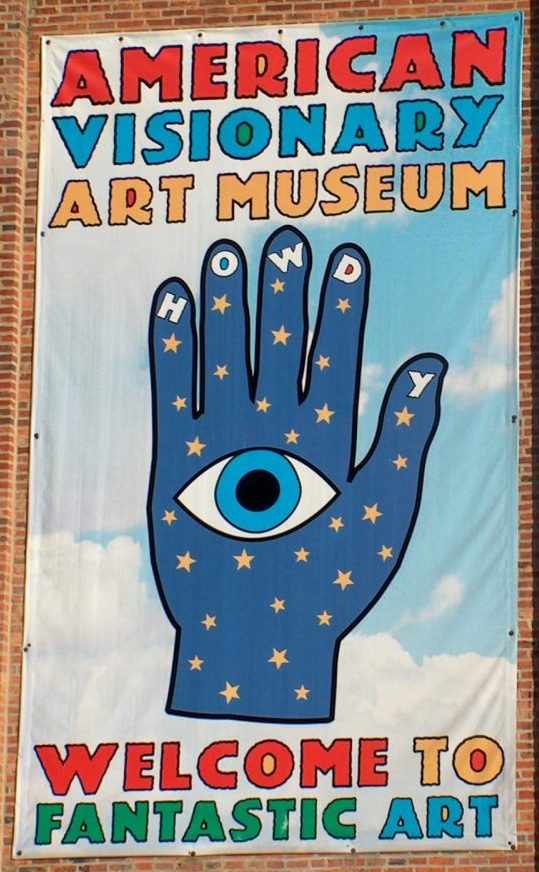
By Rich Lynch: As I mentioned in a previous essay, it shouldn’t come as a surprise to anyone who knows me for me to say that I really like museums. Art museums, history museums, science museums, cultural museums, sports museums, you name it. They’re all good. Where I live we’re blessed with the Smithsonian which has 16 museums and galleries in the Washington metro area, ten of them conveniently located adjacent to the National Mall and several others near Metrorail stops. And besides these there are dozens of others in the city that are not affiliated with the Smithsonian.
But this essay is not about any of those. Just up the road, Baltimore has its own treasure trove of museums and one of them, the American Visionary Art Museum, gets my vote as the region’s most extraordinary. It’s been described by CNN as “one of the most fantastic museums anywhere in America” and that seems pretty accurate to me. Visiting it is like being immersed in a Hieronymus Bosch painting – it’s the Museum of Earthly Delights.
Unlike the famous Bosch triptych there is normally little in the way heavenly or hellish imagery to be found at AVAM. But there’s no lack of unusual and at times surreal things to see that are truly captivating. And exhibitions hosted by the museum are always varied and eclectic. Three past examples: The Great Mystery Show, described as “one part lively fun house, two parts cosmic dream lab”, explored the human need to know and it featured works and creative investigations of visionary artists (one of them Edward Gorey), research scientists, astronauts, mystics, and philosophers. All Things Round: Galaxies, Eyeballs & Karma, billed as “a call to awareness of the circular and voluptuous nature of life”, was a multimedia extravaganza which included things like spherical sculptures by vision-impaired artists, mandelas, micro dot sock-thread embroideries, and otherworldly visions depicted by indigenous Huichol yarn art. And Human, Soul & Machine: The Coming Singularity! was an attempt by the museum to promote “an honest contemplation of the future of warfare, personal privacy, and transhumanism (the very real effort to download soul, intellect, and human memory into a machine that will not die or grow old)” and was described as “a communal look forward to where much of the Sci-Fi imaginings of the past are now swiftly becoming commonplace reality” via artwork that was “a hot-wired blend of art, science, humor, caution and hope”.
Needless to say, Nicki and I have been regular visitors to AVAM. Partly because of the pandemic it had been a couple of years since we’d last been there and we were pleased to discover there were three new so-called ‘outsider art’ exhibitions on display. One of them was a retrospective of multimedia artist Judith Ann Scott (1943-2005) titled The Secret Within. Judith was a truly remarkable person. She was a Down Syndrome baby and from birth was deaf and mostly uncommunicative. This led her parents to institutionalize her when she was age 7 and she spent her next 36 years as a ward of the State of Ohio. In 1986 Judith’s twin sister Joyce, who had not been afflicted with Down Syndrome, got custody of her after an extended legal process and brought her to northern California where she found nurturing surroundings in a boarding home which provided the care she needed. Joyce also enrolled Judith in the Creative Art Center in Oakland (an art center for people with physical and developmental disabilities) where she discovered her talent as a fiber artist. Judith incorporated various found (and sometimes pilfered) objects such as keys and magazines as cores to be enveloped by yarn and other materials. What resulted were new shapes and forms, many of them vaguely organic and cocoon-like in appearance. And in doing so, she gained national and international acclaim – her works have been on display at the Brooklyn Museum, the National Gallery in D.C., the American Folk Art Museum in New York, and now at AVAM.
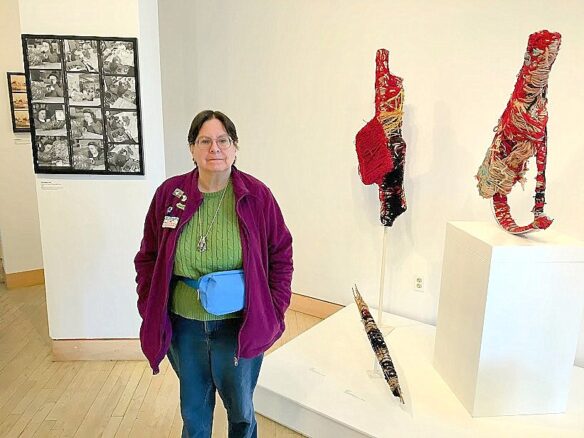
Some of the objects that were on display reminded me a bit of forms depicted by the great artist John Schoenherr on some of his covers for science fiction books and magazines. Which makes me wonder if Judith had come across old issues of Analog in her scavenging for things to incorporate into her 3D art. There was also a short video of Judith at work in the studio and even from that brief clip it was clear that she was driven to create and had realized it was her purpose in life. Would that we all could be so fortunate.
Another of the featured exhibitions was titled Esther and the Dream of One Loving Human Family. It’s not genre-related but it is in its own way extremely compelling – the life story of Holocaust survivor Esther Niesenthal Krinitz (1927-2001) as depicted in a series of fabric pictures. The series progresses from bucolic home life in rural Poland to the rounding up of Jews in the village by Nazi soldiers and then to her escape (with her younger sister) into the relative safety of a forest while her parents and other siblings, as well as all other Jews in the village were rounded up and sent off to a labor camp where they were murdered. She and her sister eventually were taken in by a farmer and his wife in a different village where they were able to survive the war, and she eventually immigrated to the USA where she created the fabric pictures that told her life story.

There was more to the exhibition than just the fabric picture series, as it also included a partial reconstruction of Esther’s pre-war farm home as well as paintings by other artists about more recent genocides. The overall aim was to “juxtapose the power of Esther’s work and story with the experience of other innocent victims of cultural genocides, historic and current” and it certainly did that.
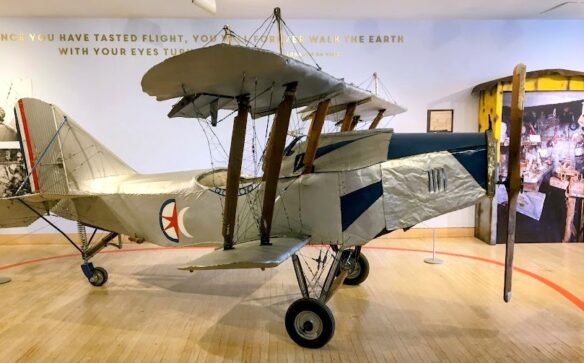
The third featured exhibition was not nearly so powerful in theme but it was just as interesting. It was titled If You Build It They Will Come: Visionary Artists and Their Environments and has been described as an attempt to “take visitors on a journey into the spaces of exceptional artists who have built their own dream worlds”. One of them was Leslie Payne (1907-1981), who lived in rural Virginia and built several faux but fairly realistic-looking airplanes. And then, with the participation of neighborhood women who played the role of ‘stewardesses’, he ‘flew’ around the world, all the while recording his adventures in a log book under the byline ‘Airplane Payne’.
Another was Zebedee Armstrong (1911-1993) from rural Georgia, who believed he’d been visited by an angel who warned him of the imminent end of the world and then became fixated on creating a ‘calculating calendar’ which would predict the exact date. He became so fixated on this that over the final two decades of his life he built somewhere around 600 such calendars, using mostly discarded and reclaimed material, from the size of an ordinary flat wall calendar to a large 3D wardrobe.
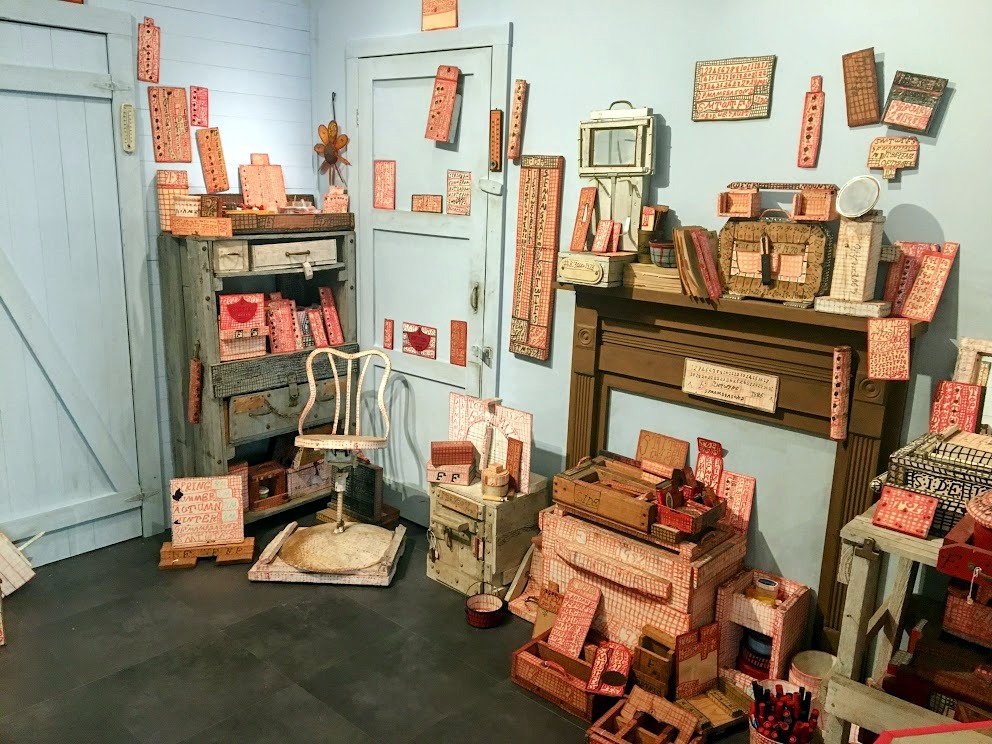
But my favorite, by far, was DeVon Smith (1926-2003), a junk dealer and science fiction/horror movie enthusiast from rural Pennsylvania who used some of the scrap metal he had on hand to build what he called the Worlds 1st Family of Robots. These are not small constructs – most of them appeared to be about 4-5 feet tall. And they all had names: Father Jupiter, Venus, Sis-tar and her brother Sun, and the dog Pluto. Later on, two others joined the family: Saturn and Mars. Even though they’re part of this special exhibition they’ve been ‘residents’ of the museum for many years – I’ve read that Saturn and Mars were ‘married’ at AVAM back in June 2000 and the ceremony was witnessed by dozens of museum attendees.


DeVon Smith is interesting for more than just his scrap metal sculptures, though. He was known for his wanderlust and his bio describes him as a former Guinness World Record holder for most miles hitchhiked (more than a half million, across four continents). He’d described himself as a ‘space traveler’ because he’d often deliberately gone to places with out-of-this-world names (Jupiter, Florida, for example). And he’d stood out in a crowd because of the outerwear he’d worn – a Doctor Who-like long black jacket with red lapels, cuffs, and shoulder epaulets, festooned with patches and pins that celebrated some of the places he’d been. This had made him a minor celebrity which had led to appearances on TV shows hosted by Art Linkletter and Groucho Marx. He was present at the museum for the robot wedding ceremony where he offered attendees some sage advice: “Don’t sit in a chair. Get out and do it.”
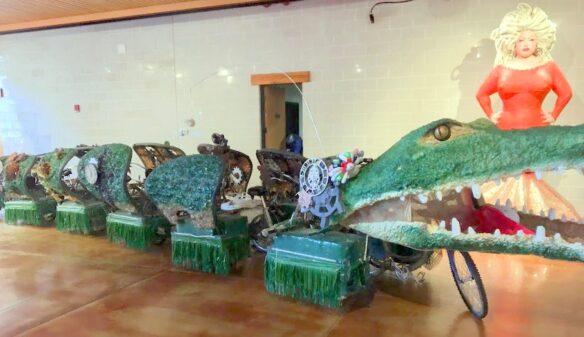
The permanent collection of AVAM is just as interesting as the special exhibitions. It’s spread out over the two buildings occupied by the museum and there’s no lack of remarkable things in it, from the sublime (a meditative sculpture garden between the two buildings) to the ridiculous (a display chronicling the history of flatulence humor, appropriately located near one of the restrooms). The museum is home to dozens of kinetic sculptures, ranging from about the size of a bread toaster all the way up to Tick Tock the Croc, a multi-segmented reptile built for the museum’s annual kinetic sculpture race and whose movement is provided by six linked-up bicycles. But my favorite is something, in its own way, equally amazing: a 16-foot-long scale model of the RMS Lusitania by craftsman Wayne Cusy (b. 1961), built entirely from toothpicks (193,000 of them). It reportedly took him 2½ years to complete, and it’s not the only large toothpick sculpture of steamships he’s ever done. When Cusy was asked why he was drawn to this kind of use for his available time, he stated that: “It’s a challenge. There’s a lot of people who like to climb mountains like Mount Everest. … I choose to build models. It’s safer.” I’m with him on that.

As you might expect, AVAM has a gift shop. And like the rest of the museum, it’s very diverse. There are things for sale such as gorgeous hand-painted Día de Los Muertos ceramic tiles from Mexico and small metal science fictional sculptures from Vietnam. And lots more. (There’s even a Zoltar fortune telling machine but that’s probably not for sale.) The gift shop is so flamboyant and eclectic that it was given a descriptive name: Sideshow. And, from what I could see, it was as much a draw for museum visitors as any of the exhibitions.
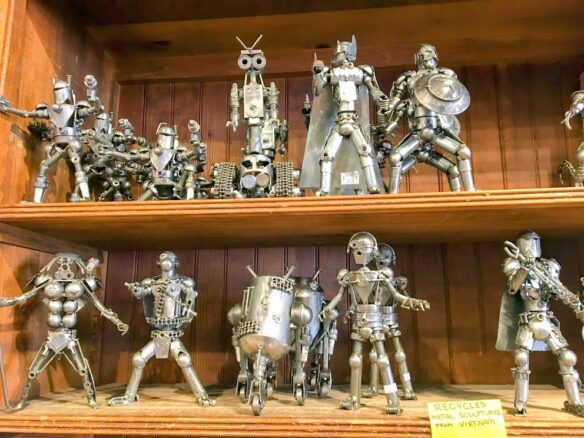
Nicki and I spent two entertaining hours at AVAM during our most recent visit there in mid-November and we could very easily have stayed a whole lot longer than that. There was quite a lot to see! Just before we departed for home I had a brief conversation with the gift shop manager, who asked me if we’d enjoyed our visit. He seemed impressed when I told him we’d been to AVAM several times, we liked it so much. And he chuckled when I told him that AVAM could be described as ‘The Museum of Earthly Delights’. He told me, “I think I’ll use that!” Hey, he has my permission!
Discover more from File 770
Subscribe to get the latest posts sent to your email.

The gift shop alone probably has enough to keep folks entertained for an afternoon. I rather fancy picking up a couple of those statuettes.
I love this wonderful treasure of Baltimore. Each visit to the museum brings so much magic from the many artist it highlights. The American Visionary Museum and John Waters are part of what makes Baltimore City great. I miss living there, but then I love my new home with Mark and our three cats.
I visited the museum many years ago while in Baltimore for a conference & on the recommendation of a former student and I absolutely agree that it is one of the most memorable and moving galleries I’ve ever experienced. I can still vividly recall some of the displays, some delightful, others disturbing but all embodying huge creativity.